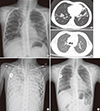1. Ratjen F, Döring G. Cystic fibrosis. Lancet. 2003; 361:681–689.
2. Kliegman RM, Stanton BF, St. Geme JW 3rd, Schor NF. Nelson Textbook of Pediatrics. 20th ed. Philadelphia, PA: Elsevier Saunders;2016.
3. Ong T, Ramsey BW. Update in cystic fibrosis 2014. Am J Respir Crit Care Med. 2015; 192:669–675.
4. Farrell PM, White TB, Ren CL, Hempstead SE, Accurso F, Derichs N, Howenstine M, McColley SA, Rock M, Rosenfeld M, et al. Diagnosis of cystic fibrosis: consensus guidelines from the cystic fibrosis foundation. J Pediatr. 2017; 181S:S4–S15.
5. Thabut G, Christie JD, Mal H, Fournier M, Brugière O, Leseche G, Castier Y, Rizopoulos D. Survival benefit of lung transplant for cystic fibrosis since lung allocation score implementation. Am J Respir Crit Care Med. 2013; 187:1335–1340.
6. Vandemheen KL, O'Connor A, Bell SC, Freitag A, Bye P, Jeanneret A, Berthiaume Y, Brown N, Wilcox P, Ryan G, et al. Randomized trial of a decision aid for patients with cystic fibrosis considering lung transplantation. Am J Respir Crit Care Med. 2009; 180:761–768.
7. Liou TG, Adler FR, Cox DR, Cahill BC. Lung transplantation and survival in children with cystic fibrosis. N Engl J Med. 2007; 357:2143–2152.
8. Crawford TC, Dickinson K, Magruder JT, Grimm JC, Bush EL, Kim BS, Merlo CA. Cystic fibrosis and pediatric lung transplantation: improved survival in the lung allocation score era. Am J Respir Crit Care Med. 2017; 195:A4849.
9. Yamashiro Y, Shimizu T, Oguchi S, Shioya T, Nagata S, Ohtsuka Y. The estimated incidence of cystic fibrosis in Japan. J Pediatr Gastroenterol Nutr. 1997; 24:544–547.
10. Jung H, Ki CS, Koh WJ, Ahn KM, Lee SI, Kim JH, Ko JS, Seo JK, Cha SI, Lee ES, et al. Heterogeneous spectrum of CFTR gene mutations in Korean patients with cystic fibrosis. Korean J Lab Med. 2011; 31:219–224.
11. Rosenblatt RL. Lung transplantation in cystic fibrosis. Respir Care. 2009; 54:777–786.
12. Kirkby S, Hayes D Jr. Pediatric lung transplantation: indications and outcomes. J Thorac Dis. 2014; 6:1024–1031.13.
13. Goldfarb SB, Levvey BJ, Edwards LB, Dipchand AI, Kucheryavaya AY, Lund LH, Meiser B, Rossano JW, Yusen RD, Stehlik J, et al. The registry of the international society for heart and lung transplantation: nineteenth pediatric lung and heart-lung transplantation report-2016; focus theme: primary diagnostic indications for transplant. J Heart Lung Transplant. 2016; 35:1196–1205.
14. Sato M, Okada Y, Oto T, Minami M, Shiraishi T, Nagayasu T, Yoshino I, Chida M, Okumura M, Date H, et al. Registry of the Japanese Society of Lung and Heart-Lung Transplantation: official Japanese lung transplantation report, 2014. Gen Thorac Cardiovasc Surg. 2014; 62:594–601.
15. Adler FR, Aurora P, Barker DH, Barr ML, Blackwell LS, Bosma OH, Brown S, Cox DR, Jensen JL, Kurland G, et al. Lung transplantation for cystic fibrosis. Proc Am Thorac Soc. 2009; 6:619–3316.
16. Jhang WK, Park SJ, Lee E, Yang SI, Hong SJ, Seo JH, Kim HY, Park JJ, Yun TJ, Kim HR, et al. The first successful heart-lung transplant in a Korean child with humidifier disinfectant-associated interstitial lung disease. J Korean Med Sci. 2016; 31:817–821.
17. Folescu TW, da Costa CH, Cohen RW, da Conceição Neto OC, Albano RM, Marques EA.
Burkholderia cepacia complex: clinical course in cystic fibrosis patients. BMC Pulm Med. 2015; 15:158.
18. Hollander FM, van Pierre DD, de Roos NM, van de Graaf EA, Iestra JA. Effects of nutritional status and dietetic interventions on survival in Cystic Fibrosis patients before and after lung transplantation. J Cyst Fibros. 2014; 13:212–218.












